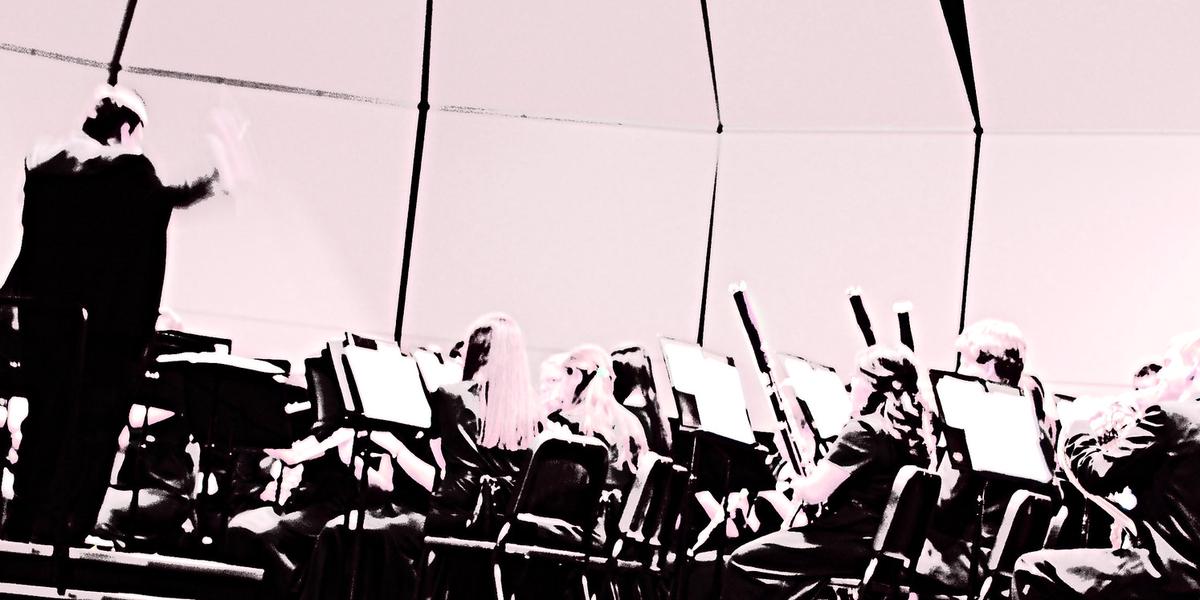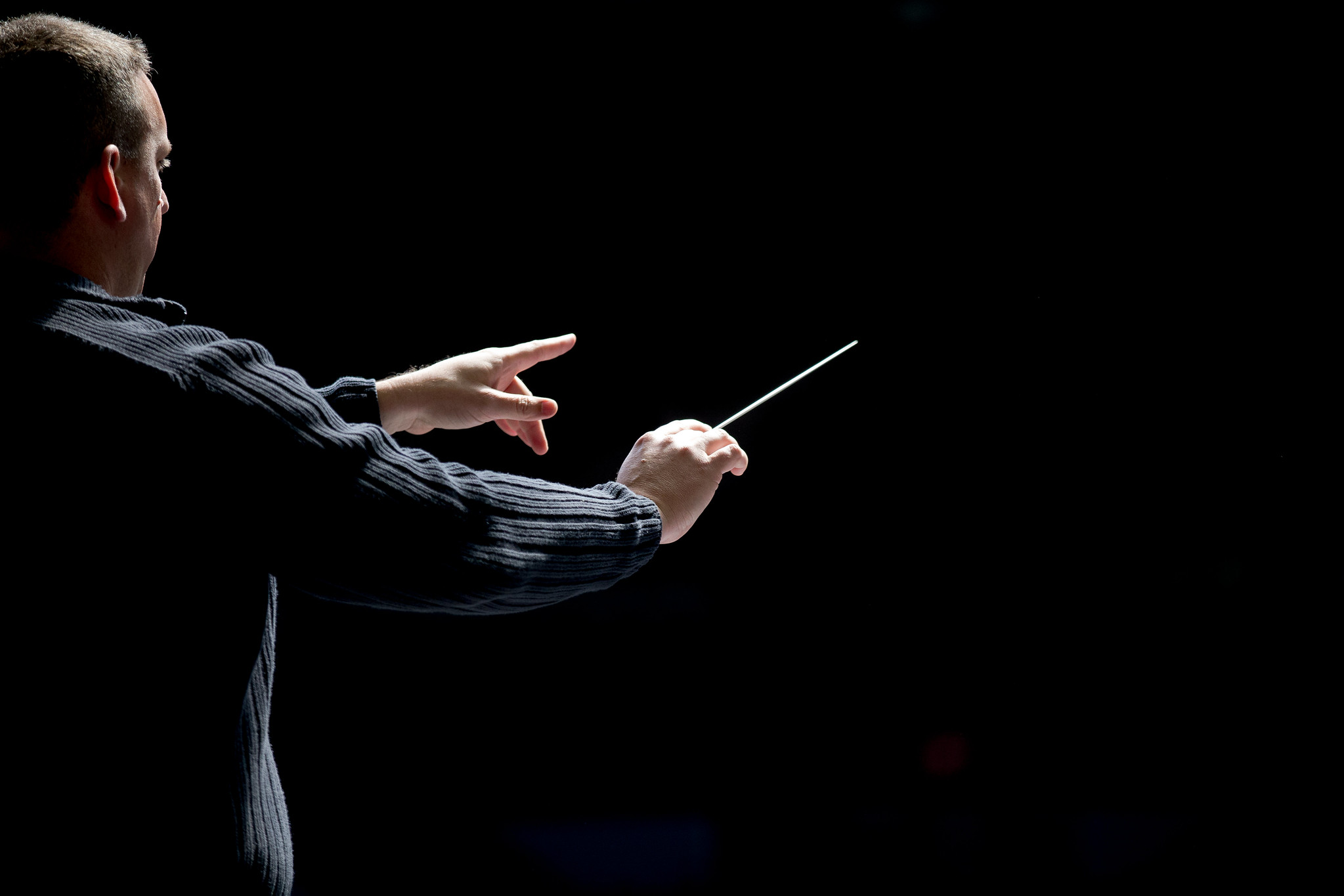How to Conduct? Where do we start with such a weighted question? Is it the technical skill of stick patterns? The knowledge of music (theory, history, etc.)? The ability to move six music stands at one time?
The short answer is yes, all of this. Most people see the conductor for the role they play in a concert: the head of the ensemble, conducting music, waving their arms in patterns to keep time, indicate dynamics, and a whole host of other musical instructions which can be communicated through their hands and/or baton. But what about the other 95% of the job? What does a conductor do?
This is the first in a series of articles all about the conductor. We are going to take the question “how to conduct” in a very broad sense here, and discuss what it is you need to know about this role in music-making.
Defining Conducting
One of my conducting professors once told me that a conductor is 10% music maker, 90% piano mover. In fact, when I was studying conducting in college, I was ignorant of the other 90%. Over time, I have gained a different perspective on the role of a conductor, and hopefully I can share that viewpoint with you. I’m going to strive for two definitions: what does it mean to conduct music, and what is a conductor.
Conducting Music (verb): the act of facilitating the performance of music with a group of musicians utilizing various physical gestures to indicate tempo, articulation, phrasing, dynamics, and other musical instructions.
Music Conductor (noun): the person responsible for facilitating an ensemble's performance through repertoire selection, rehearsal planning, ensemble preparation, inspiration, and ultimately conducting music during rehearsal and performance.
Conductors are educators, leaders, facilitators, managers, music theorists, music historians, and in many cases, piano movers. Let’s dive in further, shall we?
What Does a Conductor Do?
Conductors are Leaders
One of the aspects of conducting that can often allude a young conductor with little “real world” experience is that conductors are leaders. In many cases, the conductor is the person in charge of a musical organization or at least a part of it. They have people with whom they work and people who work for them. This could be anyone from the music librarian, personnel manager, publicity, communications, and many others.
While not all professional ensembles are set up with the conductor in charge of every aspect of the organization’s operation, undoubtedly some non-music related functions will land on the conductor's list of responsibilities, and having good leadership skills is key to success.
Even when conducting music, being able to work with the musicians, sharing ideas, and guiding the entire ensemble behind one shared goal is a leadership skill that is not always second nature.
Conductors are Educators
From the conductor of the New York Philharmonic to the conductor of Mrs. Jones 8th Grade Choir, a conductor is an educator. Part of a conductor's preparation for rehearsals and performances is studying and researching the music that is being performed. Learning about the history of the piece, performance practices, diction, and every little nuance can be shared with the ensemble. The individual musicians are typically responsible for learning their individual parts, but they are not required to understand the piece as intimately as the conductor.
This is why conductors study music history, music theory, and musicology. Those fields give them the tools to research and understand the music that they are performing so that they can have an interpretation that is authentic to them as musicians, and so that they can impart this knowledge onto the performers that they are leading, and in some cases, even the audience.
Conductors are Piano Movers
It is a very rare occurrence for a conductor to study the craft then jump straight into working with a major professional ensemble. Many conductors will spend much of their career setting up band rooms, moving pit orchestra equipment, carrying music stands from one gig to the other and so forth. This is an important aspect to understand about the profession.
However, being the piano mover (drums, music stands, etc.) can have an additional effect of strengthening your leadership skills and respect with an ensemble. It shows that you are willing to jump in and do what it takes to get the job done.
Conductors are Music Makers… Sort Of
Conductors are the only music maker on the stage who don’t actually make any music. However, they facilitate the making of music by directing their ensemble. This is the part of conducting that most people are familiar with.
There are many different types of conductors. Most universities that offer advanced studies in conducting categorize conductors as either choral or instrumental, and often instrumental conductors are broken down even further into wind ensemble and orchestral conductors.
This does not mean that one cannot do the other, but a lot has to do with the knowledge and study that accompanies those courses, including repertoire studies, lessons on individual instruments/voice, and time spent observing and conducting those particular ensembles.
Conducting Music
So if you’ve made it this far, we finally get to the most talked-about aspect of conducting, and the part that conducting students spend most of their time studying.
Many conductors use sticks, known as batons, to help guide their ensemble. This is more common in large instrumental ensembles but it has been utilized in choral settings as well.
Whether they use a baton or not, a conductor typically utilizes simple patterns of movement to indicate tempo and which beat of a measure the ensemble is on. Here is a simple video discussing some of the basic conducting patterns if you aren’t familiar with them.
At the core, these patterns indicate tempo and time. That is the number one function of conducting music, to keep an ensemble together. But there is so much more that a conductor can do with their gestures.
The speed and intensity at which each of the beats is approached can be an indicator for articulation, whether the music is legato, accented, staccato, and so forth.
The size of the pattern can indicate how loud or soft the music should be played.
The eye focus of the conductor can help highlight certain instruments over the rest of the ensemble.
And there are many more gestures and indications that are not even taught that are personal to each conductor. But if one’s intention is clear, the ensemble will understand what is being asked and respond accordingly.
In reality, the technique of conducting patterns and gestures is a relatively new thing in the history of music performance. Surviving footage of many older famous conductors will show that patterns are less a concern, and that the main focus was inspiring the musicians to make beautiful music in their own unique way. Watch Gustavo Dudamel command musicians under him in this great clip.
Conclusion
We have just scratched the surface of being a conductor. The main point I want to hammer home is that when someone asks, how to conduct, the answer is not a simple one. The amount of musical knowledge and leadership skills one must possess is immense, and that does not include the “hand waving” that must be learned to communicate musical intent to the orchestra.
I hope, at the very least, you can see the many skills that go into being a conductor. 10% Music Maker, 90% Piano Mover.


